 |
CopperSpice API
2.0.0
|
The QEasingCurve class provides easing curves for controlling animation. More...
Public Typedefs | |
| using | EasingFunction = qreal (*)(qreal progress) |
Public Types | |
| enum | Type |
Public Methods | |
| QEasingCurve (const QEasingCurve &other) | |
| QEasingCurve (Type type=Linear) | |
| ~QEasingCurve () | |
| qreal | amplitude () const |
| EasingFunction | customType () const |
| bool | operator!= (const QEasingCurve &other) const |
| QEasingCurve & | operator= (const QEasingCurve &other) |
| bool | operator== (const QEasingCurve &other) const |
| qreal | overshoot () const |
| qreal | period () const |
| void | setAmplitude (qreal amplitude) |
| void | setCustomType (EasingFunction func) |
| void | setOvershoot (qreal overshoot) |
| void | setPeriod (qreal period) |
| void | setType (Type type) |
| Type | type () const |
| qreal | valueForProgress (qreal progress) const |
Friends | |
| QDataStream & | operator<< (QDataStream &stream, const QEasingCurve &easing) |
Related Functions | |
These are not member functions | |
| QDataStream & | operator>> (QDataStream &stream, const QEasingCurve &easing) |
Detailed Description
The QEasingCurve class provides easing curves for controlling animation.
Easing curves describe a function that controls how the speed of the interpolation between 0 and 1 should be. Easing curves allow transitions from one value to another to appear more natural than a simple constant speed would allow. The QEasingCurve class is usually used in conjunction with the QVariantAnimation and QPropertyAnimation classes but can be used on its own. It is usually used to accelerate the interpolation from zero velocity (ease in) or decelerate to zero velocity (ease out). Ease in and ease out can also be combined in the same easing curve.
To calculate the speed of the interpolation, the easing curve provides the function valueForProgress(), where the progress argument specifies the progress of the interpolation: 0 is the start value of the interpolation, 1 is the end value of the interpolation. The returned value is the effective progress of the interpolation. If the returned value is the same as the input value for all input values the easing curve is a linear curve. This is the default behavior.
will print the effective progress of the interpolation between 0 and 1.
When using a QPropertyAnimation, the associated easing curve will be used to control the progress of the interpolation between startValue and endValue:
The ability to set an amplitude, overshoot, or period depends on the QEasingCurve type. Amplitude access is available to curves that behave as springs such as elastic and bounce curves. Changing the amplitude changes the height of the curve. Period access is only available to elastic curves and setting a higher period slows the rate of bounce. Only curves that have "boomerang" behaviors such as the InBack, OutBack, InOutBack, and OutInBack have overshoot settings. These curves will interpolate beyond the end points and return to the end point, acting similar to a boomerang.
- See also
- setAmplitude()
Member Typedef Documentation
Member Enumeration Documentation
| enum QEasingCurve::Type |
The type of easing curve.
| Constant | Value | Description |
|---|---|---|
QEasingCurve::Linear | 0 | 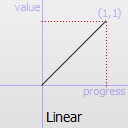 Easing curve for a linear (t) function: velocity is constant. |
QEasingCurve::InQuad | 1 | 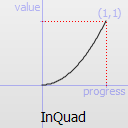 Easing curve for a quadratic (t^2) function: accelerating from zero velocity. |
QEasingCurve::OutQuad | 2 | 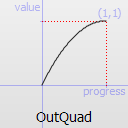 Easing curve for a quadratic (t^2) function: decelerating to zero velocity. |
QEasingCurve::InOutQuad | 3 | 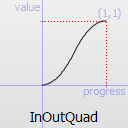 Easing curve for a quadratic (t^2) function: acceleration until halfway, then deceleration. |
QEasingCurve::OutInQuad | 4 | 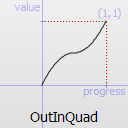 Easing curve for a quadratic (t^2) function: deceleration until halfway, then acceleration. |
QEasingCurve::InCubic | 5 | 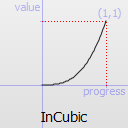 Easing curve for a cubic (t^3) function: accelerating from zero velocity. |
QEasingCurve::OutCubic | 6 | 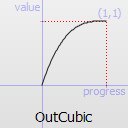 Easing curve for a cubic (t^3) function: decelerating to zero velocity. |
QEasingCurve::InOutCubic | 7 | 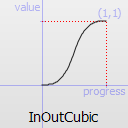 Easing curve for a cubic (t^3) function: acceleration until halfway, then deceleration. |
QEasingCurve::OutInCubic | 8 | 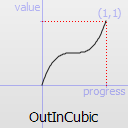 Easing curve for a cubic (t^3) function: deceleration until halfway, then acceleration. |
QEasingCurve::InQuart | 9 | 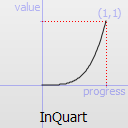 Easing curve for a quartic (t^4) function: accelerating from zero velocity. |
QEasingCurve::OutQuart | 10 | 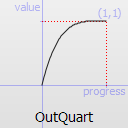 Easing curve for a quartic (t^4) function: decelerating to zero velocity. |
QEasingCurve::InOutQuart | 11 | 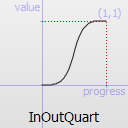 Easing curve for a quartic (t^4) function: acceleration until halfway, then deceleration. |
QEasingCurve::OutInQuart | 12 | 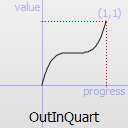 Easing curve for a quartic (t^4) function: deceleration until halfway, then acceleration. |
QEasingCurve::InQuint | 13 | 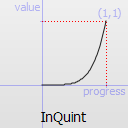 Easing curve for a quintic (t^5) easing in: accelerating from zero velocity. |
QEasingCurve::OutQuint | 14 | 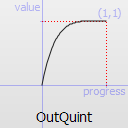 Easing curve for a quintic (t^5) function: decelerating to zero velocity. |
QEasingCurve::InOutQuint | 15 | 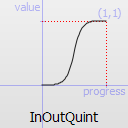 Easing curve for a quintic (t^5) function: acceleration until halfway, then deceleration. |
QEasingCurve::OutInQuint | 16 | 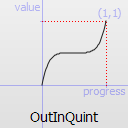 Easing curve for a quintic (t^5) function: deceleration until halfway, then acceleration. |
QEasingCurve::InSine | 17 | 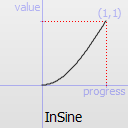 Easing curve for a sinusoidal (sin(t)) function: accelerating from zero velocity. |
QEasingCurve::OutSine | 18 | 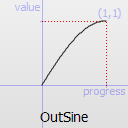 Easing curve for a sinusoidal (sin(t)) function: decelerating from zero velocity. |
QEasingCurve::InOutSine | 19 | 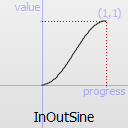 Easing curve for a sinusoidal (sin(t)) function: acceleration until halfway, then deceleration. |
QEasingCurve::OutInSine | 20 | 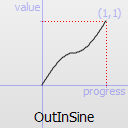 Easing curve for a sinusoidal (sin(t)) function: deceleration until halfway, then acceleration. |
QEasingCurve::InExpo | 21 | 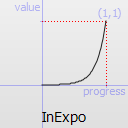 Easing curve for an exponential (2^t) function: accelerating from zero velocity. |
QEasingCurve::OutExpo | 22 | 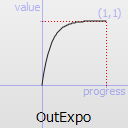 Easing curve for an exponential (2^t) function: decelerating from zero velocity. |
QEasingCurve::InOutExpo | 23 | 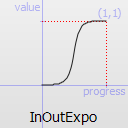 Easing curve for an exponential (2^t) function: acceleration until halfway, then deceleration. |
QEasingCurve::OutInExpo | 24 | 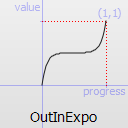 Easing curve for an exponential (2^t) function: deceleration until halfway, then acceleration. |
QEasingCurve::InCirc | 25 | 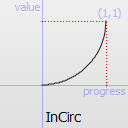 Easing curve for a circular (sqrt(1-t^2)) function: accelerating from zero velocity. |
QEasingCurve::OutCirc | 26 | 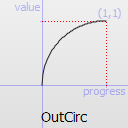 Easing curve for a circular (sqrt(1-t^2)) function: decelerating from zero velocity. |
QEasingCurve::InOutCirc | 27 | 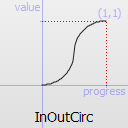 Easing curve for a circular (sqrt(1-t^2)) function: acceleration until halfway, then deceleration. |
QEasingCurve::OutInCirc | 28 | 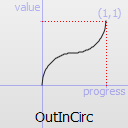 Easing curve for a circular (sqrt(1-t^2)) function: deceleration until halfway, then acceleration. |
QEasingCurve::InElastic | 29 | 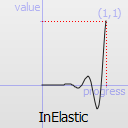 Easing curve for an elastic (exponentially decaying sine wave) function: accelerating from zero velocity. The peak amplitude can be set with the amplitude parameter, and the period of decay by the period parameter. |
QEasingCurve::OutElastic | 30 | 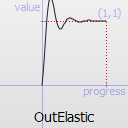 Easing curve for an elastic (exponentially decaying sine wave) function: decelerating from zero velocity. The peak amplitude can be set with the amplitude parameter, and the period of decay by the period parameter. |
QEasingCurve::InOutElastic | 31 | 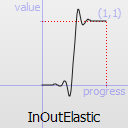 Easing curve for an elastic (exponentially decaying sine wave) function: acceleration until halfway, then deceleration. |
QEasingCurve::OutInElastic | 32 | 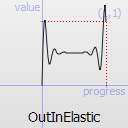 Easing curve for an elastic (exponentially decaying sine wave) function: deceleration until halfway, then acceleration. |
QEasingCurve::InBack | 33 | 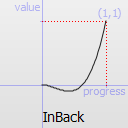 Easing curve for a back (overshooting cubic function: (s+1)*t^3 - s*t^2) easing in: accelerating from zero velocity. |
QEasingCurve::OutBack | 34 | 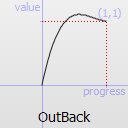 Easing curve for a back (overshooting cubic function: (s+1)*t^3 - s*t^2) easing out: decelerating to zero velocity. |
QEasingCurve::InOutBack | 35 | 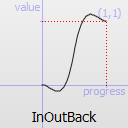 Easing curve for a back (overshooting cubic function: (s+1)*t^3 - s*t^2) easing in/out: acceleration until halfway, then deceleration. |
QEasingCurve::OutInBack | 36 | 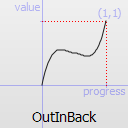 Easing curve for a back (overshooting cubic easing: (s+1)*t^3 - s*t^2) easing out/in: deceleration until halfway, then acceleration. |
QEasingCurve::InBounce | 37 | 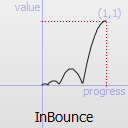 Easing curve for a bounce (exponentially decaying parabolic bounce) function: accelerating from zero velocity. |
QEasingCurve::OutBounce | 38 | 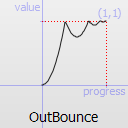 Easing curve for a bounce (exponentially decaying parabolic bounce) function: decelerating from zero velocity. |
QEasingCurve::InOutBounce | 39 | 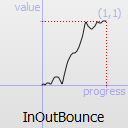 Easing curve for a bounce (exponentially decaying parabolic bounce) function easing in/out: acceleration until halfway, then deceleration. |
QEasingCurve::OutInBounce | 40 | 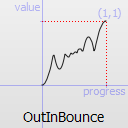 Easing curve for a bounce (exponentially decaying parabolic bounce) function easing out/in: deceleration until halfway, then acceleration. |
QEasingCurve::Custom | 45 | This is returned if the user specified a custom curve type with setCustomType(). You can not call setType() with this value, but type() can return it. |
Constructor & Destructor Documentation
| QEasingCurve::QEasingCurve | ( | Type | type = Linear | ) |
Constructs an easing curve of the given type.
| QEasingCurve::QEasingCurve | ( | const QEasingCurve & | other | ) |
Construct a copy of other.
| QEasingCurve::~QEasingCurve | ( | ) |
Destroys the current QEasingCurve object.
Method Documentation
| qreal QEasingCurve::amplitude | ( | ) | const |
Returns the amplitude. This is not applicable for all curve types. It is only applicable for bounce and elastic curves (curves of type() QEasingCurve::InBounce, QEasingCurve::OutBounce, QEasingCurve::InOutBounce, QEasingCurve::OutInBounce, QEasingCurve::InElastic, QEasingCurve::OutElastic, QEasingCurve::InOutElastic or QEasingCurve::OutInElastic).
- See also
- setAmplitude()
| EasingFunction QEasingCurve::customType | ( | ) | const |
Returns the function pointer to the custom easing curve. If type() does not return QEasingCurve::Custom, this function will return 0.
- See also
- setCustomType()
|
inline |
Compares the current QEasingCurve with other and returns true if they are not equal. It will also compare the properties of a curve.
- See also
- operator==()
| QEasingCurve & QEasingCurve::operator= | ( | const QEasingCurve & | other | ) |
Copy assigns from other and returns a reference to this object.
| bool QEasingCurve::operator== | ( | const QEasingCurve & | other | ) | const |
Compares the current QEasingCurve with other and returns true if they are equal. It will also compare the properties of a curve.
| qreal QEasingCurve::overshoot | ( | ) | const |
Returns the overshoot. This is not applicable for all curve types. It is only applicable if type() is QEasingCurve::InBack, QEasingCurve::OutBack, QEasingCurve::InOutBack or QEasingCurve::OutInBack.
- See also
- setOvershoot()
| qreal QEasingCurve::period | ( | ) | const |
Returns the period. This is not applicable for all curve types. It is only applicable if type() is QEasingCurve::InElastic, QEasingCurve::OutElastic, QEasingCurve::InOutElastic or QEasingCurve::OutInElastic.
- See also
- setPeriod()
| void QEasingCurve::setAmplitude | ( | qreal | amplitude | ) |
Sets the amplitude to amplitude. This will set the amplitude of the bounce or the amplitude of the elastic "spring" effect. The higher the number the higher the amplitude.
- See also
- amplitude()
| void QEasingCurve::setCustomType | ( | EasingFunction | func | ) |
Sets a custom easing curve which is defined by the function func. The signature of the custom function must be as shown below. The range for progress and the return value is normalized between 0 and 1. The value for func can not be a nullptr.
- See also
- customType(), valueForProgress()
| void QEasingCurve::setOvershoot | ( | qreal | overshoot | ) |
Sets the overshoot to overshoot. A value of 0 produces no overshoot. The default value of 1.70158 produces an overshoot of 10 percent.
- See also
- overshoot()
| void QEasingCurve::setPeriod | ( | qreal | period | ) |
Sets the period to period. Setting a small period value will give a high frequency of the curve. A large period will give it a small frequency.
- See also
- period()
Return the effective progress for the easing curve at progress. While progress must be between 0 and 1, the returned effective progress can be outside those bounds. For instance, QEasingCurve::InBack will return negative values in the beginning of the function.
Friends And Related Function Documentation
|
friend |
Writes the given easing to the stream. Returns a reference to the stream.
Refer to Serializing Data Types for additional information.
|
related |
Reads from the stream into the given easing. Returns a reference to the stream.
Refer to Serializing Data Types for additional information.


